11.02.2013 | In 2010 in Prague, the remains of Tycho Brahe were exhumed, and in the autumn of 2012 the research results were published.It proved Tycho Brahe was not poisoned. The Exhibition of the Tomb Research of Tycho de Brahe with the participation of the National Museum maps individual steps of the research. The exhibitions open on February 12thin the premises of Academy of Science
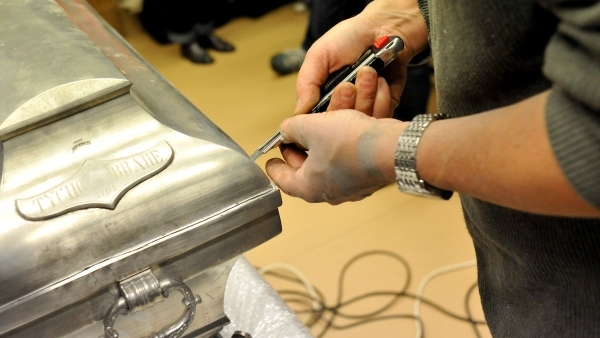
The preparation for the research of the remains of Tycho de Brahe was in progress from 2006, when the historian, Herman Kölln, visited the Antropological Department of the National Museum, and introduced information on the intension of Jens Vellev from Aarhus University to exhume the remains of the Danish astronomer Tycho Brahe. The following year, Jens Vellev visited the Anthropological Department of the National Museum. They agreed on the conditions, which had to be adhered to enable the exhumation.
The agreement was that if the tomb is open, the Anthropology Department of National Museum would organize the research of the remains and provide the background for the event. The negotiations lasted until February 2010, when Jens Vellev received all required permissions for the exhumation, including the consent of the National Heritage Institute and in particular from Roman Catholic Archdiocese of Prague. From 2009, the meetings with Jens Vellev in the National Museum included Jaroslav Brůžek from the Anthropology Department of University of West Bohemia, who joined the project also based on his former contacts with Danish Anthropologists.
The research of the Tycho Brahe remains and his tomb had four main goals:Verify the originality of the bone remains of Tycho Brahe, find out the osteobiographic data using the temporary methods, perform 2D and 3D skeleton documentation of the astronomer, and take samples for chemical / biological analysis from the skeleton of Tycho de Brahe and his wife.
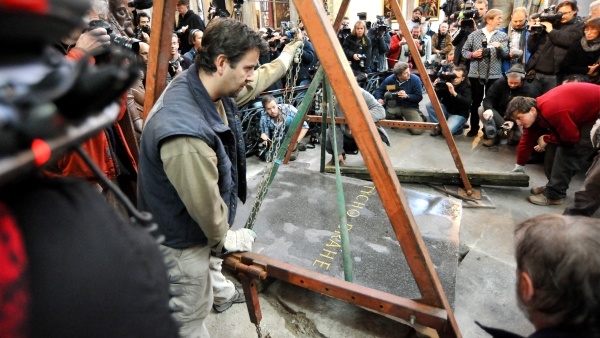
Biological research was performed at the workplace of the Anthropological Department of the National Museum where the X-ray, photographic and morphological documentation of the remains was completed.
After opening the metal box titled ‘Tycho Brahe 1901’, the content appeared comprising of the secondary placed bones of one individual (in non-anatomic order). During the first phase the biological samples were taken respecting the principles of the contamination minimizing. The content of the box was gradually removed. The funeral garment was the last located item. The skeletal remains were then assembled in anatomic order, which clearly indicated that the right upper half of the skeleton was strongly damaged and incomplete. The box also contained two glass vessels. The larger vessel included the remains of facial skeleton with beard and the authenticity certificate from Dr. Jindřich Matiegka from 1901. The smaller glass vessel contained the residues of organic material.
The results of the gender estimation confirmed that the pelvis bones definitely belonged to a man. Based on the file of ten dimensions and reference data from almost two thousand individuals of known age and gender, the probability of male gender reaches its maximum, in the left and right pelvis bone.
Advanced state of the changes in the joint surface of the pubis corresponds to an individual over 40 years of age. The character of the changes in the facies auricularis of the hipbone corresponds tot he age of death over 50 with probability exceeding 0.95 which complies with the known death of Tycho Brahe (54).
The height was estimated according to the femur length and humerus length to 175 ± 2 cm. Jindřich Matiegka measured in 1901 total length of the body in situ 168-170 cm. Tycho Brahe was tall.
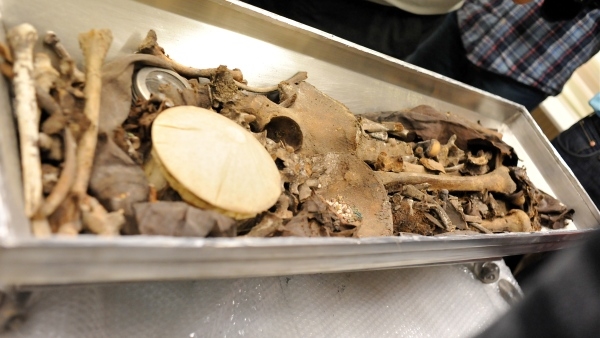
The total of 13 teeth remained from the upper jaw in situ. Teeth are more grinded on the right side of dental arch, which indicates that Tycho Brahe was right handed. Only six loose teeth remained from the lower jaw indicating the individual suffered from periodontitis.
In the area of the nasal opening (apertura piriformis) the residues of green shade were found as described by Jindřich Matiegka in his report. The colour caused by the presence of copper ions can indicate the use of nasal attachment. Nose and nasal bone injury, which the astronomer suffered in battle is not visible.
‘When we researched the remains of Tycho Brahe in 2010, we took miniature samples from the entrance to the nasal cavity and the analysis was performed by the team of Prof. Kučera. He found out it contained high concentrations of copper and zinc in the same ratio, indicating the nasal prosthesis was not made from gold and silver alloy; rather most likely from brass,’ explained Dr. Vellev.
Postcranial skeleton does not indicate any noticeable signs of diseases, injury or accidents. The degenerative changes are noticeable on all spinal parts, in particular the transfer of the thoracic and lumbar area. Spondylotic changes are more extensive than in common findings of the same age category in current population. More significant changes were also present in the ligament and muscle insertion, which may relate with higher age and also physical activity.
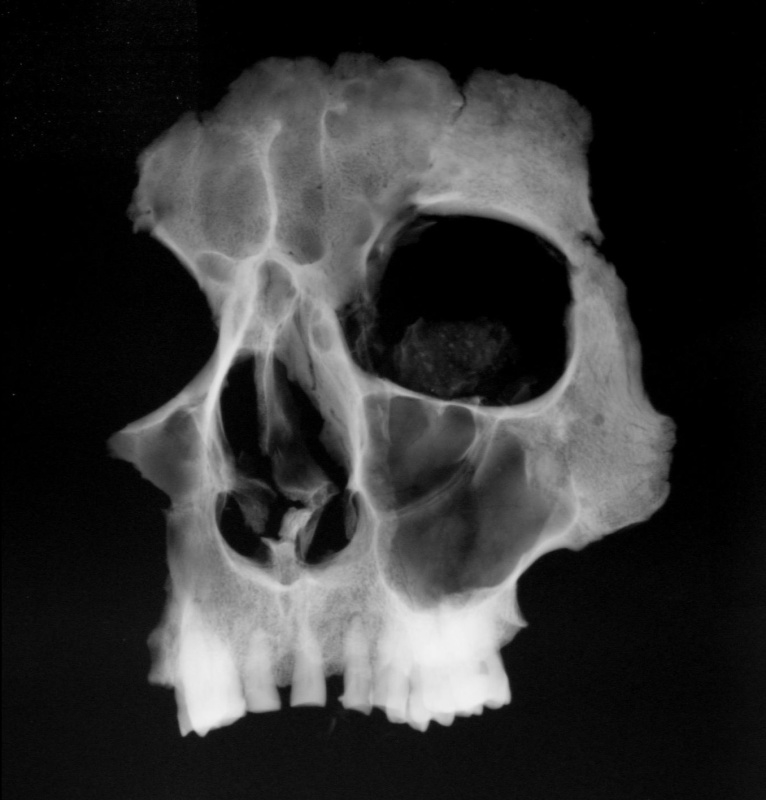 The study confirmed the skeleton authenticity of Tycho Brahe. The current methods indicate that the skeleton belonged to man over fifty, 173 to 177 cm tall.
The study confirmed the skeleton authenticity of Tycho Brahe. The current methods indicate that the skeleton belonged to man over fifty, 173 to 177 cm tall.
Premature death of Tycho Brahe was a mystery for over 400 years. The famous astronomer died on the 24thof October 1601 – only eleven days after his sudden illness, and many myths and theories occurred around his death during the centuries, including the mercury poisoning.
Concentration of mercury was searched by Dr. Kaare Lund Rasmussen from the University of Southern Denmark in Odense and the team of Prof. Ing. Jana Kučery, CSc., from the Nuclear Physics Department at the Academy of Science of the Czech Republic, v. v. i., in Řež. ‘We measured the mercury concentration with three independent analytical methods and all tests had the same conclusion: The concentration of mercury was not sufficient to cause death. The bone analysis results indicate that Tycho Brahe was not exposed to high levels of mercury in the last five to ten years of his life,’ stated Dr. Rasmussen, who performed the bone sample analysis using the method of atomic absorption spectrometry using the technique of cold vapours in Odense.
Beard analysis was performed in the Nuclear Physics Department at the Academy of Science of the Czech republic in Řež using the radio-chemical neutron activation analysis and proton micro-probe, installed recently in the new charged particle accelerator TANDETRON. ‘The concentration of mercury in approximately 2 cm beard indicate mercury exposure in the last two months of Tycho Brahe's life. The content of mercury drops from the values only slightly higher than common concentrations in the current unexposed population, two months prior death to the lower values of common concentrations in the last two weeks prior to Tycho Brahe's death’, says Prof. Kučera.
It is therefore conformed the cause of death of the famous Danish astronomer Tycho Brahe, who spent his last years working at the court of Rudolf II in Prague, was not mercury poisoning as indicated by some theories.
Interesting notes: The permanent presence of media and high number of specialists must be qualified as non-standard approach in medical-anthropological research of historical personnel. Expert research of the skeleton, including the documentation and sampling was restricted to three incomplete days.
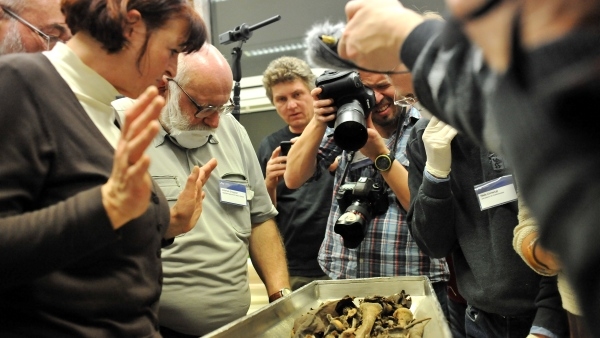
(dan)
Archeologie Historie Hudba Lidová kultura Mimoevropské kultury Osobnosti Přírodní vědy Rekonstrukce Restaurování Rukopisy a tisky Umění Vánoce Výstavy
Muzeum 3000, zpravodajský portál Národního muzea, odhaluje jedinečná tajemství. Více se dozvíte zde!